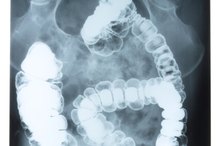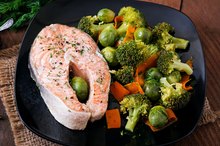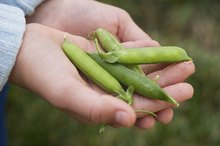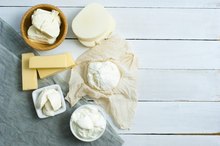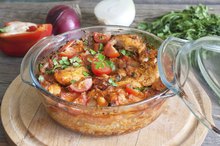What does fact checked mean?
At Healthfully, we strive to deliver objective content that is accurate and up-to-date. Our team periodically reviews articles in order to ensure content quality. The sources cited below consist of evidence from peer-reviewed journals, prominent medical organizations, academic associations, and government data.
The information contained on this site is for informational purposes only, and should not be used as a substitute for the advice of a professional health care provider. Please check with the appropriate physician regarding health questions and concerns. Although we strive to deliver accurate and up-to-date information, no guarantee to that effect is made.
Diets That Help Prevent Pancreatitis & Acid Reflux
Pancreatitis is the inflammation of the lining of the pancreas, which is an organ that helps the body absorb the nutrients from the foods you eat. Acid reflux occurs when the valve located at the end of the esophagus does not completely close the entrance to the stomach. As a result, stomach acid and food leak into the esophagus, causing irritation and inflammation. Both conditions can be painful and debilitating, depending on the severity of the inflammation. Fortunately, fundamental changes in your diet can relieve the symptoms of both pancreatitis and acid reflux.
If you are experiencing serious medical symptoms, seek emergency treatment immediately.
Give up caffeine. Limit or avoid beverages that contain caffeine, such as coffee and soft drinks. According to the University of Pennsylvania School of Medicine, these types of beverages can cause additional irritation of the pancreas and esophagus 3. Alternatively, drink between 48 oz. and 64 oz. of water every day but limit the amount of liquid you drink with a meal. This allows your stomach to utilize its acid to digest foods most effectively. In addition, UPSM advises that you remain in an upright position for two hours following a meal, to reduce the chances of acid reflux.
A Post Pancreatitis Diet
Learn More
Eat whole foods. Replace highly processed foods in your diet with fiber and nutrient-rich foods, such as fresh fruits, vegetables and whole grain products. If you have pancreatitis, focus on consuming leafy dark green vegetables and seaweed, which are good sources of iron and B vitamins. According to the University of Maryland Medical Center, eating foods high in these nutrients can help reduce the risk of inflammation and can relieve symptoms of pancreatitis 2. Foods that are high in fiber are important to aid the digestive process and can help keep your digestive system work optimally.
Use healthy fats. Avoid rich, high fat foods, and don't eat foods that contain trans-fatty acids, usually labeled as hydrogenated fats. Foods that are high in fat, according to the UPSM, are associated with acid reflux and the University of Maryland Medical Center adds that these foods can increase the risk or severity of symptoms of pancreatitis 2. Focus instead on using healthy fats such as olive or vegetable oil for cooking or baking. Consume fish that is high in omega-3 fatty acids at least once a week. Omega-3 fatty acids help to relieve inflammation and improve your immunity, reducing and preventing pancreatitis.
Foods That Will Heal the Pancreas
Learn More
Cut out red meat. Reduce or eliminate your consumption of red meat and instead eat lean proteins such as skinless white-meat poultry; beans; tofu; and coldwater, low-fat fish. According to the University of Maryland Medical Center, red meat can aggravate the inflammation associated with pancreatitis 2. Individuals with acid reflux derive benefit from eating lower-fat proteins because they help reduce excess weight. UPSM advises that individuals experiencing acid reflux can relieve many of their symptoms by maintaining a healthy weight.
Tips
Eat several meals a day, rather than three large ones. This helps your body digest smaller amounts of food at a time, decreasing the possibility of excess stomach acid that can irritate inflamed digestive tissues.
Warnings
Consult your doctor before making significant dietary changes.
Related Articles
References
- MedlinePlus: GERD
- University of Maryland Medical Center: Pancreatitis
- University of Pennsylvania School of Medicine: UPHS Nutrition Care Guide: Managing Heartburn With Diet
- Spanier BWM, Dijkgraaf MGW, Bruno MJ. Epidemiology, aetiology and outcome of acute and chronic pancreatitis: An update. Best practice & research Clinical gastroenterology. 2008;22(1):45-63. doi:10.1016/j.bpg.2007.10.007
- Rasmussen HH. Nutrition in chronic pancreatitis. World Journal of Gastroenterology. 2013;19(42):7267. doi:10.3748/wjg.v19.i42.7267
- Clinical practice guideline: management of acute pancreatitis – Canadian Journal of Surgery. Canjsurg.ca. http://canjsurg.ca/vol59-issue2/59-2-128/. Published 2016.
- Castiñeira-Alvariño M, Lindkvist B, Luaces-Regueira M, et al. The role of high fat diet in the development of complications of chronic pancreatitis. Clinical Nutrition. 2013;32(5):830-836. doi:10.1016/j.clnu.2013.02.002
- Conwell, Darwin L., et al. American Pancreatic Association Practice Guidelines in Chronic Pancreatitis. Pancreas, vol. 43, no. 8, Nov. 2014, pp. 1143–1162, doi:10.1097/mpa.0000000000000237
- Duggan, S, Conlon, K. A Practical Guide to the Nutritional Management of Chronic Pancreatitis. Practical Gastroenterology. June 2013; 118: 24-32.
- Singh, Siddharth, et al. Dietary Counseling Versus Dietary Supplements for Malnutrition in Chronic Pancreatitis: A Randomized Controlled Trial. Clinical Gastroenterology and Hepatology, vol. 6, no. 3, Mar. 2008, pp. 353–359, doi:10.1016/j.cgh.2007.12.040
- Vonlaufen, Alain, et al. Molecular Mechanisms of Pancreatitis: Current Opinion. Journal of Gastroenterology and Hepatology, vol. 23, no. 9, Sept. 2008, pp. 1339–1348, doi:10.1111/j.1440-1746.2008.05520.x
- Yadav D, Lowenfels A. The Epidemiology of Pancreatitis and Pancreatic Cancer. Gastroenterology. 2013;144(6):1252-1261. doi:10.1053/j.gastro.2013.01.068
Tips
- Eat several meals a day, rather than three large ones. This helps your body digest smaller amounts of food at a time, decreasing the possibility of excess stomach acid that can irritate inflamed digestive tissues.
Warnings
- Consult your doctor before making significant dietary changes.
Writer Bio
Maura Banar has been a professional writer since 2001 and is a psychotherapist. Her work has appeared in "Imagination, Cognition and Personality" and "Dreaming: The Journal of the International Association for the Study of Dreams." Banar received her Bachelor of Arts in psychology from Buffalo State College and her Master of Arts in mental health counseling from Medaille College.



